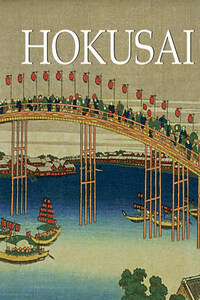© Confidential Concepts, worldwide, USA
© Parkstone Press International, New York, USA
Image-Bar www.image-bar.com
All rights reserved.
No part of this publication may be reproduced or adapted without the permission of the copyright holder, throughout the world. Unless otherwise specified, copyright on the works reproduced lies with the respective photographers, artists, heirs or estates. Despite intensive research, it has not always been possible to establish copyright ownership. Where this is the case, we would appreciate notification.
* * *
Self-Portrait of Hokusai at Eighty-Three, 1842.
Ink on paper, 26.9 × 16.9 cm.
Rijksmuseum Volkenkunde, Leiden.
1760: Katsushika Hokusai is born in Edo.
1763: The three-year-old Hokusai is adopted by Nakajima Ise, a mirror polisher working for the Tokugawa Shogunate. Soon in his childhood, he begins to learn woodblock carving. His career starts when he becomes an apprentice as an engraver at age fourteen.
1778: Hokusai enters the studio of Katsukawa Shunshō, one of the leading woodblock artisans of the time, where he learns the technique of woodcut printmaking. After one year, he publishes his first works, actor prints, under the name Shunrō.
1789: Hokusai leaves the establishment because of a disagreement with the master’s successor, Shunko. This is a major turning point in his life.
1790s: First known surimono by Hokusai produced. Moves away from the standard motifs found in ukiyo-e (actors and courtesans) towards landscapes and scenes of daily life in Japan. This reorientation represents a breakthrough on a personal level as well as one on in relation to ukiyo-e art. During this period he attains success as a woodblock artist, doing a number of series on the legend of the Chūshingura.
1800: He produces the Famous Places in Edo and fifteen sketch books which were published in 1814 under the title Hokusai manga. After undertaking about thirty different pseudonyms, he assumes the name Katsushika Hokusai, as he is known today. His unusually-large amount of name changes reflects the change in his artistic creativity.
early 1830s: He produces the landscape prints which are now considered his greatest works. While this series was still coming out, he began his other famous series, such as Voyage to the Waterfalls of the Various Provinces (Shokoku taki meguri) and Thirty-Six Views of Mount Fuji (Fugaku sanjūrokkei), comprised of forty-six prints.
1834–1836: Due to his age, Hokusai suffers from intermittent paralysis which affects the quality of his work. However, he continues to paint and jokingly assumes the name ‘gakyō-rōjin’ (the old man mad with painting). Completes the three volumes of One Hundred Views of Mount Fuji (Fugaku hyakkei), Picturesque Views of Famous Bridges from Various Provinces (Shokoku meikyō kiran), and the bird and flower series, all in this period. The last notable work was a series entitled the One Hundred Poets (Shûga Hiakounin lsshu).
1839: Hokusai suffers the loss of all his paintings and drawings in his workshop during a fire. Although he continues to produce more works, principally brush-painting, for the next ten years after the loss of his collection in the fire, the quality falters compared to his earlier works.
1849: He dies on 18 April (or 10 May), at the age of ninety. After his death, copies of some of his woodblock prints are sent to the West, and along with the works of other ukiyo-e artists, his prints influence Western masters such as Vincent van Gogh and Paul Gauguin.
In the autumn of 1760, a child was born in a humble suburb of Edo whose place in the world’s art was destined to be important. His adoptive parents were from the artisan class; the father a maker of metal mirrors to the court of the Shogun, the mother a member of a family that was not without celebrity in its time, but had lighted upon evil days.
Kintoki the Herculean Child with a Bear and an Eagle
c. 1790–1795
Nishiki-e (polychrome woodblock print), 37.2 × 24.8 cm (ōban)
Ostasiatische Kunstsammlung, Museum für Asiatische Kunst, Staatliche Museen zu Berlin, Berlin
Her grandfather had been a retainer of the courtier Kira, in whose defence he had fallen by the hand of one of the forty-seven ronin during the midnight attack, the climax of that tragic episode of 17th-century Japan. Perhaps to this soldier ancestor, we may trace the pride and independence that characterised Hokusai all his life, just as the employment of his father might be supposed to influence the child’s tastes and capacity in the direction of art.
Actor Ichikawa Komazô III as Shirai Gonpachi and Actor Matsumoto Kôshirô IV as Banzui Chôbei
c. 1791
Diptych, nishiki-e (polychrome woodblock print), 31.8 × 13.7 cm; 31.8 × 14.4 cm
Museum of Fine Arts, Boston
Possibly because he was not an only son, he left home at fourteen to be apprenticed to an engraver. Though he did not remain at this trade for more than four years, the experience thus gained must have been exceedingly useful to him later in life, when he had to direct the men who were cutting his own work. At the age of eighteen he left this employment to join the school of the great designer, Shunshō, whose colour prints are among the treasures of modern collectors.








